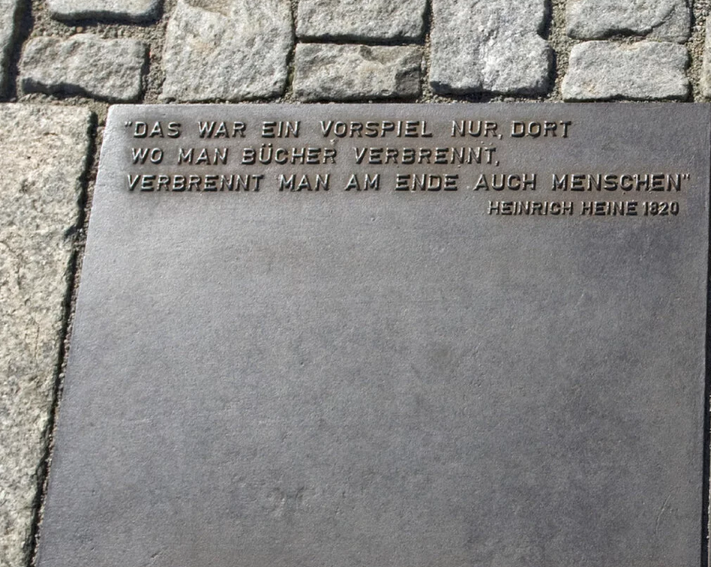Horror beneath the surface: a warning for our time

How can memorials powerfully remind us of past horrors? How can they keep the atrocities of the past alive and relevant? Micha Ullmann's Berlin memorial (above, by day) fulfils those requirements. It commemorates the fascist blaze, when ninety years ago, on 10 May 1933, 20,000 works by a great number of German and international authors were devoured by the flames before an ecstatic crowd.
Ullmann's memorial is located on Berlin's Bebelplatz – underneath it, to be precise. It is not visible from the street by day –- but at night, an eternal light illuminates it (below, by night). The memorial is a seven-square-metre space, a good five metres high, plastered white, with empty white wooden shelves lining its sides. They could accommodate 20,000 books. Ullmann demonstrates loss – loss of knowledge, experience, art, pleasure. The emptiness reflects a cultural void.

The space can be viewed through a square pane, set into the paving of the square. During the day, the sun, clouds and people are all reflected in the pane and it takes a certain effort and concentration to perceive the empty shelves through it. This is part of the artistic concept. To approach history, to fully grasp it, takes effort. The pane becomes an intersection of the present and the past – the Now is reflected in this glass plate, which at the same time becomes a transparent grave slab, allowing access to the past. The viewer almost feels dizzy/faint, as the window appears fragile – could one fall into the past here?
Insight and resistance
This interface between history and the present also represents an interplay between the private sphere of a library and the public sphere of Berlin's historic centre, between inside and outside, between reality and the imagined, evoked by the memorial. Along with a grave, the empty library also evokes a protected space. Apart from the obvious loss, the imagination refills the shelves with the burnt books and keeps them in a safe place, like a bunker, in the exact place where the inconceivable happened. The eternal light functions both as the eternal light of remembrance and as a source of energy, where shock can turn into insight and resistance.
Micha Ullmann's family fled from Dorndorf in Thuringia to Palestine in 1933, where he was born in Tel Aviv in 1939. His basic idea for the Berlin memorial is grounded in a symbolism that is a leitmotif in the artist’s work. Another memorial based on the excavation of a pit is his first important work "Messer/Metzer" from 1972. Together with young Palestinians and Israelis, Ullmann symbolically exchanged soil between the Arab village of Messer and the Jewish kibbutz of Metzer, neighbouring villages whose names both mean the same thing in Arabic and Hebrew: Border. In both locations, pits of the same size were dug and filled with the soil of the other village. Here, too, there was hardly anything visible on the surface. Here, too, the viewers are challenged to to approach, see and understand what is being presented and referenced.
The Berlin memorial emphases the beginnings of fascism. The torching of books heralded the unimaginable. Very close to the memorial is a plaque, also set on the square’s plaster stones, with Heine’s prophetic words from his tragedy “Almansor”: “This was a prelude only, where you burn books, you will, in the end, burn people. (Heinrich Heine 1820)”.

It should not be forgotten that it was the so-called intelligentsia that carried out the book burning – students and their professors, also librarians and the book trade. This act of book burning contributed significantly to preparing the intellectual ground for fascism. How quickly supposedly cultured and educated people lose their facade and reveal their true stripes! This phenomenon is very evident again today. The fascist concept of Gleichschaltung (enforced conformity) may well be underway, where thinking independent of the establishment is suppressed and made punishable by law.
As fascism grew, almost all German writers left their home country – a step not taken lightly by those whose art lies in their native language. Very few authors stayed. The vast majority continued writing in exile, and German literature during the Nazi regime is a literature of exile.
Erich Kästner was one of the few who remained in Germany, and Hans Fallada was another. Kästner was also the only author who witnessed his own books burning in Berlin, including his novel Fabian (1931, The Story of a Moralist, in English translation). Kästner's Fabian is not actively involved in the political struggle. Written before the Nazis seized power, the novel is set during the last years of the Weimar Republic. Although Fabian distances himself from the rising German fascists and sees himself as a friend of the communists, he counts on “decency” prevailing.
In his 1950 preface to a new edition of the novel, Kästner described his aim as pointing to the abyss towards which Germany was moving. The novel criticises above all the passivity of those who recognise the dangerous deterioration in society but do nothing about it. This theme is of the greatest relevance today.

Jenny Farrell
Jenny Farrell is a lecturer, writer and an Associate Editor of Culture Matters.
Latest from Jenny Farrell
- Poetry for the Many, an anthology by Jeremy Corbyn and Len McCluskey
- A hopeful vision of human renewal: the theatre of Seán O'Casey
- Art that's rooted in the upheavals of his time: Caspar David Friedrich, 1774-1840
- A Drive to Change the World: James Baldwin, Black Author, Socialist and Activist
- A woman's perspective on the invisible front: A review of 'The Shadow in the Shadow'
